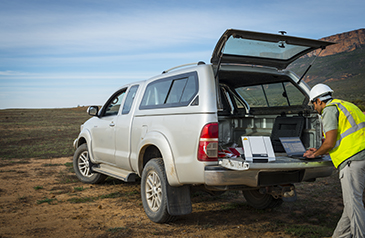Vehicular Network System (VNS) is a new category of satellite communications (“SATCOM”)-enabled solutions being developed by FirstNet and Viasat Government Services for public safety customers to combine the best of LTE and satellite for true “go anywhere” vehicle connectivity.
VNS combines an off-the-shelf In-Vehicle Router (IVR) system with multiple communication input capability and the ability to intelligently select between the connectivity paths. One input slot is used for cellular LTE and serves as the primary connection. A second SATCOM connection is connected to another input slot and utilized – based on rules set by the user – as directed or needed whenever LTE coverage is unavailable.
VNS provides customers with maximum flexibility by providing options to purchase individual components or the entire VNS system that can be integrated with existing IVR installations.
VNS systems are designed to provide cellular or satellite connectivity to enable in-vehicle communications and/or extending a Wi-Fi “bubble” of connectivity to a small number of users outside the vehicle. VNS systems are not the same as a “deployable” portable cell tower which can provide LTE service to a large number of users via a high-speed satellite backhaul connection. For more information on deployable LTE systems, please visit FirstNet.com.
Typical elements include:
- Rugged IVR with multiple ports, automatic failover/ failback capabilities and local Wi-Fi broadcast capability
- LTE (5-in-1) rooftop antenna and SIM with FirstNet service plan
- Satellite Solutions VNS bundle-Satellite antenna, transceiver and service plan
- IVR automatically switches connection between cellular LTE and satellite.
VNS Options And Use Cases
VNS can be used to support multiple use cases; each use case requires different equipment and the VNS should be designed and configured to support the specific use case needed. Please contact us for a detailed consultation on your desired use case and the VNS configurations capable of best meeting your needs. Common VNS use cases include:
Broadband Communications on the Move (COTM):
- These systems use standard IVR and FirstNet LTE connectivity plus a vehicle-mounted mid-broadband (128-492 kbps) satellite data antenna/modem to support data, voice or limited video applications while a vehicle is on the move.
- The SATCOM equipment is generally a medium-sized (19” x 6”) magnetic roof-mounted tracking antenna affixed to the vehicle roof that is connected to a Broadband Global Area Network (BGAN) modem in the trunk which is in turn connected to the IVR.
- These systems provide bandwidth similar to a cellular 2.5G connection while outside of LTE coverage range and are suitable for most data applications other than streaming video.
- The BGAN roof-mounted antenna is able to automatically reposition itself as the vehicle moves in order to maintain connectivity. The SATCOM connection can be programmed to connect anytime that the vehicle is out of LTE range, or only at pre-selected or on-demand intervals in order to provide cost containment.

Broadband Communications on the Halt (COTH):
- These systems use standard IVR and FirstNet LTE connectivity plus a mid-broadband (492kbps) satellite data antenna/modem to support data, voice or limited video applications when a vehicle is halted and the satellite antenna is manually deployed.
- The SATCOM equipment is generally a medium-sized (13 x 2”) Broadband Global Area Network (BGAN) modem, which is stored in the trunk and is connected to the IVR or a compact Flyaway 65cm terminal/modem, which is stored in the trunk and is connected to the IVR and standard AC outlet or DC to AC power car adapter.
- To use the satellite connectivity, the user must park their vehicle and place the BGAN or Flyaway terminal antenna/modem system outdoors on/around the vehicle; these systems can typically power up and connect in two minutes or less, and less than 15 minutes of training is required to learn to deploy the system.
- These systems provide bandwidth similar to a cellular 2.5G connection while outside of LTE coverage range and are suitable for most data applications.
- The SATCOM connection is used only when the vehicle operator chooses to halt and deploy it (such as at the request of a dispatcher in order to send or receive important information), which provides cost control while still maintaining on-demand connectivity.

